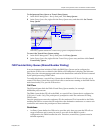
Chapter 7-Entry Queues, Ad Hoc Conferences and SIP Factories
Polycom, Inc. 7-7
To designate an Entry Queue as Transit Entry Queue:
1 In the RMX Management - Rarely Used pane, click Entry Queues.
2 In the Entry Queues list, right-click the Entry Queue entry and then click Set Transit
Entry Queue.
The Entry Queue selected as Transit Entry Queue is displayed in bold.
To cancel the Transit Entry Queue setting:
1 In the RMX Management - Rarely Used pane click Entry Queues.
2 In the Entry Queues list, right-click the Transit Entry Queue entry and then click Cancel
Transit Entry Queue.
IVR Provider Entry Queue (Shared Number Dialing)
In an environment that includes a DMA, the RMX Entry Queue can be configured to
provide the IVR Services on behalf of the DMA to SIP endpoints. It displays the Welcome
Slide, plays the welcome message and retrieves the destination conference ID that is entered
by the participant using DTMF codes.
To enable this feature, a special Entry Queue that is defined as IVR Service Provider only is
created. This Entry Queue does not forward calls to conferences running on the RMX and its
main functionality is to provide IVR services.
Call Flow
The SIP participant dials the DMA Virtual Entry Queue number, for example
1000@dma.polycom.com.
The DMA forwards the SIP call to the RMX, to a special Entry Queue that is configured as
IVR Service Provider Only. The participant is prompted to enter the conference ID using
DTMF codes.
Once the participant enters the conference ID, the conference ID is forwarded to the DMA,
enabling the DMA to connect the SIP endpoint to the destination conference or create a new
conference and connect the participant to that conference.
Guidelines
• An Entry Queue defined as IVR service provider only does not route the SIP call to a
target conference and it cannot be used to rout calls on the RMX. In such a
configuration, the DMA handles the calls
. Therefore, normal Entry Queues must be
defined separately.


















